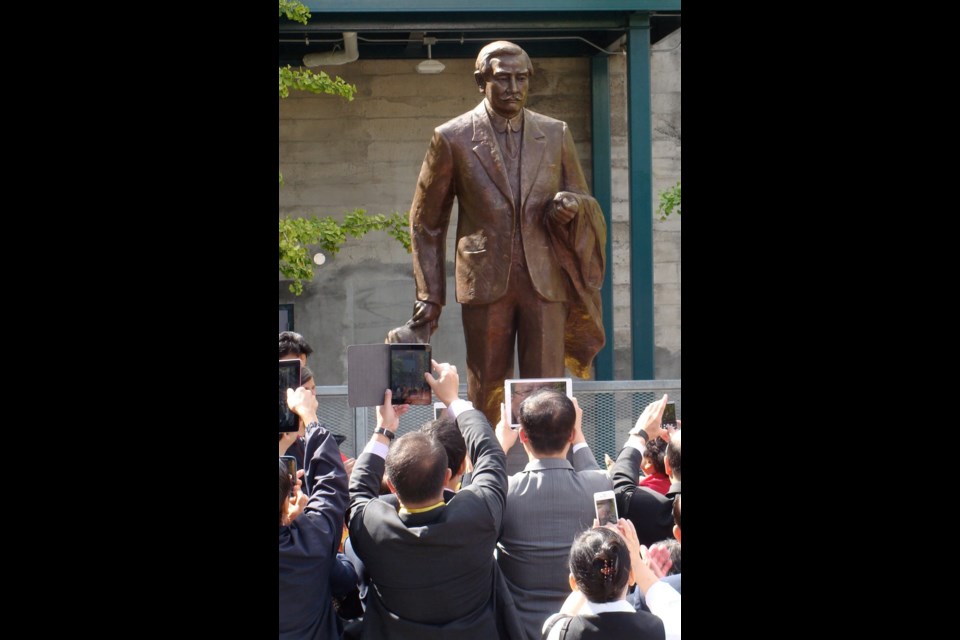 My friend Derek came to visit from Massachusetts, and we took a bicycle ride through our lovely city.
My friend Derek came to visit from Massachusetts, and we took a bicycle ride through our lovely city.
After rolling along Beach Drive, we stopped at Harling Point, the oldest Chinese cemetery in the country. It’s a peaceful place, with a huge altar table and two chimneys, where offerings of roast pigs and flowers and tea and whiskey are made each spring at the Qing Ming festival to honour the dead.
The park was made a national historic site years ago, and is now well maintained, with informative signs about the First Nations and Chinese uses of this quiet spot.
Then, we made our way to the Moss Street Market, the first of the new generation of markets (since the old City Market was torn down to make way for city hall expansion in about 1959). Traditional and artisanal vegetable producers line Moss Street and are a magnet for locals every Saturday.
Foremost among the potters with tables there is Harumi Ota, whose long background in the traditional potteries of western Japan has resulted in his amazing skill at wheel-throwing. His porcelain bowls, of unusual fineness, may also be seen at Eclectic Gallery in Oak Bay.
We rode on, somewhat sustained by a sour cherry turnover and a double-chocolate cookie from the market, and before long we were facing Mungo Martin’s big house at Thunderbird Park. In the late 1940s, Martin was employed to make recreations of the totems that had been collected by the provincial museum. This was at a time when the “potlatch laws” were still in effect and it was illegal to participate in native culture.
When asked to build a traditional house for Thunderbird Park, he built a smaller replica of his own house at Fort Rupert and in this house, in 1953, the first newly “legal” potlatch was held shortly after the laws were repealed. The house remains the property of his family.
We stood to name the figures on a few of the replica poles in the park and then, as we passed the glassed-in walls of the museum’s northeast corner, we looked at the actual old poles. Many of them are simple and rather awesome Salish house posts.
The Salish people, whose domain extends as far north as Campbell River, carved house posts but not totem poles, but now there seems to be a need for them. Before the Commonwealth Games, Cicero August and his family carved a large pole, now on the lawn of the legislature. It was designed in a unique new style, including a loon with folded wings on top, and a very curious frog painted bright green at the base.
Avoiding the gauntlet of Government Street, we threaded our way through Bastion Square, noting the terrific public sculpture by Illarion Gallant, of a skeletal canoe with a load of berries slipping through the weeds. Bastion Square, instigated by artist Allan Edwards, was the first winner of a national award for heritage architecture restoration in the 1960s.
In the early 1970s, Nick Bawlf masterminded the evolution of a ravine full of sheds into a civic amenity, as Market Square. Its own Saturday market was in full flight when we went through.
Crossing Pandora, we entered Fan Tan Alley, a narrow passageway that leads through to Fisgard. Called “the narrowest street” in the country, it is privately owned and not really a municipally assumed thoroughfare.
The atmosphere of Fan Tan Alley, a “city within a city,” remains almost as funky and mysterious as it was when the Chinese used it as a place to avoid unwanted attention of the white folks.
But it has curious glamour, and while we were there, despite the noonday crowd, a wedding party in tuxes and wedding dresses were in the midst of a full-on professional photo shoot. The happy couple were photographed kissing under the sign of Heart’s Content, the longest-running shop on the alley.
At Government and Fisgard, we passed a statue under wraps, about to be unveiled. It is a bronze, larger than life, of Dr. Sun Yat Sen, the man who led the revolution that overthrew the Qing Dynasty in China in 1911. Sun visited Victoria three times to raise money for the cause, and the statue was unveiled last Sunday by his granddaughter, Dr. Lily Sun, on the occasion of the centennial of the Dart Coon Society. It is the 153rd statue of him she has unveiled around the world.
Just beyond the statue, in what used to be known as Centennial Square, the Victoria India Mela was taking place, with hyper-enthusiastic dancers holding the stage. Derek and I found the food carts irresistible and, while we ate our curry, we sat on the margin of the fountain, with its totem-esque mosaic designed by Jack Wilkinson in 1971.
Our destination was Legends Comics at 633 Johnson St. I went there to pick up a copy of a new comic book, Roach Town, created by Peter Sandmark. As this is Vol. 1, No. 1, it’s sure to be a collector’s item.
Sandmark is the director of MediaNet, Victoria’s filmmaking co-operative, and Roach Town is his first book. The drawings are rather elementary and remind me a bit of George Herriman’s Krazy Kat. The tough-talking story line is couched in the hardboiled words of a film noir. The story concerns neonicotinoids, which are killing bees, though the evil Dr. Mantis is trying to blame it on the tobacco ringspot virus.
The cultural mix of Victoria including Chinese, Japanese, Kwak Waka Wak’w, Coast Salish and South Asian is unique in Canada, and always makes it a rewarding place to visit on a Saturday. Get on your bike and take a look!



